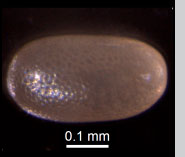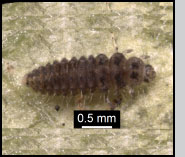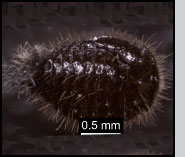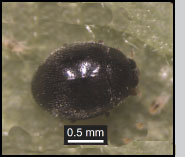![]() |
Back to Pathogens Table of Contents

Stethorus punctillum
(Coleoptera: Coccinellidae)
Eric W. Riddick, M. Guadalupe Rojas, Juan Morales-Ramos, Margaret Allen, National Biological Control Laboratory, USDA-ARS,
Stoneville, MS 38776, USA, and Brian Spencer, Applied Bio-nomics Ltd, Sidney, BC V8L5P5, Canada
Stethorus punctillum Weise belongs to a moderate-sized family of lady beetles (a. k. a., ladybirds or ladybugs) containing approximately 3,500 species worldwide, with almost 500 species in North America. The cosmopolitan genus Stethorus contains approximately 65 species; six species occur in America north of Mexico (1). The adults and larvae of all species in the genus Stethorus are specialized predators of mites (2). S. punctillum is of European origin. Therefore, it is an exotic species in North America. Its historical distribution extends from west Europe to Japan (3). S. punctillum first arrived from Turkey in 1955 for biological control of citrus red mite and avocado brown mite in orchards in southern California, USA, but did not become established (4). Unintentional introductions of S. punctillum have resulted in its establishment in southern Canada, the west coast of the United States, and northeastern United States. The distribution of S. punctillum probably overlaps with the distribution of a related native species, Stethorus punctum picipes Casey along the west coast (1).

Appearance
Stethorus adults are very small, hairy, oval-shaped black beetles with yellow mouthparts and antennae, with variable amounts of yellow to brownish-yellow coloration on legs (1). All six North American species, including S. punctillum, are no more than a few millimeters in total body length as adults. Total body mass of an adult ranges from 400 to 500 micrograms. S. punctillum pupae are also hairy and black (see image below) and larvae are grayish in color, rather slow moving with conspicuous legs (see image below). Larvae crawl from plant to plant in search of mites. Eggs are oval shaped and yellowish in color
(see image below). In contrast to many other lady beetles that deposit their eggs in clusters, S. punctillum deposit their eggs singly, on the underside of leaves of plants infested with spider mites.

Pests Attacked (Host Range)
Under field conditions, S. punctillum occurs in orchards, tree plantations, gardens, and crop fields where it attacks two-spotted spider mite (Tetranychus urticae Koch) and other mites in the family Tetranychidae (2). It attacks spider mites
in greenhouses, interiorscapes, nurseries and orchards (2, 5). Examples of pests, other than T. urticae, attacked include European red mite, Panonychus ulmi (Koch), spruce spider mite, Oligonychus ununguis (Jacobi), and southern red mite, Oligonychus ilicis (McGregor).

Life Cycle
Adult females deposit their eggs on the underside of leaves of plants infested with mites. Newly emerged adult females require a period of approximately one week before they begin laying eggs, and only if an adequate density of spider mites is available. Adult
females emerge with no or just a few mature eggs in their ovaries, thus continuous feeding on preferred prey is necessary for egg maturation. For example, females must consume at least 20 spider mites per day to commence and sustain egg production. Some reports
suggest that adults prefer eating spider mite eggs rather than larval, nymphal or adult stages (6). Females lay from 3 – 13 eggs per day. The total egg production can exceed 1,000 eggs over a lifespan of up to two years, under field conditions (and overwintering).
Laboratory or greenhouse cultures of S. punctillum produce no more than 150 eggs (on average) when fed spider mites, of all life stages, during a lifespan of less than 60 days without any winter storage (7; 8). The egg stage lasts three to five days,
depending on rearing temperature. The egg stage and the first instar larval stage experience the highest mortality, for reasons that are not clear. Larvae feed and develop through four instars within eight to nine days. Note that a single larva can consume
240 spider mites during its development to the pupal stage. Mature larvae move toward the lower portions of the plant to pupate, most often on the underside of leaves. Pupae require 6 - 8 days to emerge as adults. The entire life cycle takes two weeks at 26ºC.
The optimum temperature for rearing S. punctillum ranges from 23 to 25ºC.

Relative Effectiveness in IPM Systems
In integrated pest management (IPM) systems for suppression of spider mites, S. punctillum is compatible with predatory mites. This predator is effective in IPM systems to control spider mites on peppers and cucumbers, but not tomatoes, in greenhouses (9) at temperatures ranging from 20 to 30ºC. Although not determined experimentally,
ineffectiveness on tomato may be due to trichomes on tomato leaves, which could ensnare S. punctillum larvae. Additionally, cultural practices for greenhouse tomatoes involve aggressive pruning, which could dislodge any S. punctillum larvae and pupae on plants during this process.
Stethorus punctillum is effective at a relative humidity from 30 to 90% (10). Combinations of predators, the specialist lady beetle, S. punctillum, and generalist predatory mite, Amblyseius californicus McGregor, are more successful at reducing spider mites (T. urticae) than either species used alone (11). Genetically engineered crops, such as maize, containing
insecticidal proteins, derived from the microbe Bacillus thuringiensis Berliner, have little or no negative effects on the life history and effectiveness of S. punctillum (12; 13). However, all host plants are not suitable substrates for S. punctillum larvae. Lima bean Phaseolus lunatus L. leaf trichomes impale larvae, reducing survival rate (14). Scarlet runner bean, Phaseolus coccineus L., leaf trichomes tear through the integument of S. punctillum larvae (15). Detailed knowledge of the interactions of host plants (crops), spider mites, and S. punctillum is required to increase the use of this predator in IPM systems. Another important concern is the compatibility of S. punctillum releases with pesticides used to control a variety of pests in IPM systems.

Pesticide Compatibility
Stethorus punctillum adults and larvae are compatible with fenbutatin (Vendex®), which is an organotin miticide, for added control of spider mites in “hot-spots” at normal field rates. Overuse of this product will reduce S. punctillum density on plants through a reduction in their food supply (spider mites). Pyrethroid and organophosphate insecticides can alter the seasonal activity of S. punctillum (16). Fenoxycarb (Insegar® DG), which is a carbamate insect growth regulator, and methoxyfenozide (Intrepid® 2F), which is a diacylhydrazine insecticide that induces premature and incomplete molting in lepidopteran larvae, are both known
to have adverse effects on the development, emergence, and reproduction of S. punctillum (17). Other products such as soaps, supreme oils, and spreader-stickers can be harmful to S. punctillum if they come into direct contact with the sprays. These products have very little residual activity against S. punctillum. There is evidence that S. punctillum can develop resistance to organophosphate insecticides (e.g., azinphosmethyl) under field conditions (18).

Commercial Availability
There is an expanding market for Stethorus punctillum and other predators such as phytoseiid mites (e.g., P. persimilis) that can help control spider mites (5). S. punctillum is available for purchase from Applied Bio-nomics and Sesil Corporation Biological Systems. There is a need for a more cost-effective rearing system for this natural enemy, since the cost of producing it is high (i. e., from 30 to 50 USD per 100 adults). The USDA and Applied Bio-nomics are conducting research
to discover ways of rearing this predator at a lower cost.

Acknowledgments:
We thank Jill Eccleston for inviting us to write this manuscript. Mention of a commercial or proprietary product does not constitute an endorsement of the product by the United States Department of Agriculture.

References
[1] Gordon RD (1985) The Coccinellidae (Coleoptera) of America north of Mexico. Journal of the New York Entomological Society 93:1-912
[2] Biddinger DJ, Weber DC, Hull LA (2009) Coccinellidae as predators of mites: Stethorini in biological control. Biological Control 51:268-283
[3] Kapur AP (1948) On the Old World species of the genus Stethorus Weise (Coleoptera, Coccinellidae). Bulletin of Entomological Research 39:297-320
[4] McMurtry JA (1978) Tetranychidae, pp. 3-8, In: Clausen CP (Ed), Introduced parasites and predators of arthropod pests and weeds: a world review. Agriculture Handbook No. 480. Agricultural Research Service, USDA, Washington, DC
[5] van Lenteren JC (2003) Commercial availability of biological control agents. In: van Lenteren JC (Ed) Quality control and production of biological control agents, theory and testing procedures. CABI Publ, Oxon, pp. 167-179
[6] Ragkou VS, Athanassiou CG, Kavallieratos NG, Tomanovi? Ž (2004) Daily consumption and predation rate of different Stethorus punctillum instars feeding on Tetranychus urticae. Phytoparasitica 32:154-159
[7] Riddick EW, unpublished data
[8] Jiang TR, Zhang LB, Wei XT (1982) Biology of Stethorus punctillum Weise (Col.: Coccinellidae) and its utilisation. Natural Enemies of Insects 4:34-36 (In Chinese)
[9] Raworth DA (2001) Development, larval voracity, and greenhouse releases of Stethorus punctillum (Coleoptera: Coccinellidae). Canadian Entomologist 133:721-724
[10] Rott AS, Ponsonby DJ (2000) The effects of temperature, relative humidity and host plant on the behaviour of Stethorus punctillum as a predator of the two-spotted spider mite, Tetranychus urticae. BioControl 45:155-164
[11] Rott AS, Ponsonby DJ (2000) Improving the control of Tetranychus urticae on edible glasshouse crops using a specialist coccinellid (Stethorus punctillum Weise) and a generalist mite (Amblyseius californicus McGregor) as biocontrol agents.
Biocontrol Science and Technology 10:87-498
[12] Álvarez-Alfageme F, Ferry N, Castañera P, Ortego F, Gatehouse AMR (2008) Prey mediated effects of Bt maize on fitness and digestive physiology of the red spider mite predator Stethorus punctillum Weise (Coleoptera: Coccinellidae). Transgenic Research 17:943-954
[13] Li Y, Romeis J (2010) Bt maize expressing Cry3Bb1 does not harm the spider mite, Tetranychus urticae, or its ladybird beetle predator, Stethorus punctillum. Biological Control 53:337-344
[14] Riddick EW, Wu Z (2011) Lima bean – lady beetle interactions: hooked trichomes affect survival of Stethorus punctillum larvae. BioControl 56:55-63
[15] Putman WL (1955) Bionomics of Stethorus punctillum Weise (Coleoptera: Coccinellidae) in Ontario. Canadian Entomologist 87:9-33
[16] Roy M, Brodeur J, Cloutier C (2005) Seasonal activity of the spider mite predators Stethorus punctillum (Coleoptera: Coccinellidae) and Neoseiulus fallacis (Acarina: Phytoseiidae) in raspberry, two predators of Tetranychus mcdanieli (Acarina: Tetranychidae). Biological Control 34:47-57
[17] Nienstedt KM, Miles M (2008) Aged-residue method for evaluating toxicity of plant protection products to Stethorus punctillum (Weise) (Coleoptera: Coccinellidae). Pesticides and Beneficial Organisms, IOBC/wprs Bulletin 35:122-127
[18] Croft BA (1990) Arthropod biological control agents and pesticides. Wiley, New York

Back to Pathogens Table of Contents

|
| 



|
| Stethorus punctillum egg, larva (3rd instar), pupa, and adult; from top to bottom, respectively
{Photo credit: E. W. Riddick and Z. Wu}
|
|
